This article originally appeared in the June 2020 issue of Security Business magazine. When sharing, don’t forget to mention @SecBusinessMag on Twitter and Security Business magazine on LinkedIn.
The National Safety Council reports that 16% of all workplace deaths in 2017 resulted from workplace violence. A chronic and growing problem, there are four types of workplace violence incidents defined by the National Institute for Occupational Safety and Health: criminal intent, customer/client, worker-on-worker, and incidents occurring as a result of personal relationships. Perhaps most jarringly, each of these types of workplace violence have taken the form of active shooter incidents in recent years.
The threat of active shooter incidents looms large in the nation’s consciousness – and therefore should be a major consideration for security integrators. The FBI, the most definitive source of statistics on the topic, reports that an active shooter event occurs once every 26 days, with each averaging between three to four fatalities. The FBI statistics say that between 2000 and 2017, the U.S. has experienced 250 active shooter incidents, with 799 victims killed and 1,418 wounded.
FBI studies have concluded that active shooter events can happen anywhere; however, the two greatest at-risk markets are commercial businesses (42%) and educational institutions (20.8%). For school shootings, the problem is especially concerning since the shooter is often – but not always – younger and lacking an emotional maturity and capability to understand all the implications of their actions.
Another factor contributing to the complexity in preventing and responding to active shooter incidents is that they usually take place over a very short period of time, with most events lasting only between 2-12 minutes – which offers little time to react and stop an ongoing threat.
Particularly for integrators, this poses a unique challenge. As true partners to end-users, the design of a security system and program goes far beyond technology deployment. There is a highly human element to these kinds of incidents; thus, it is important to create a security and response plan that is anticipatory, so events like this can be prevented, but also to simultaneously prepare and orchestrate an immediate response.
Statistics about an active shooter in the workplace and educational institutions is revealing; whether it is genuinely growing or remaining static, the perception is that the threat is more prevalent than ever. Given this, it is imperative that security integrators take the necessary steps to become a comprehensive educational resource on the threat, remain dedicated to a high standard of service, and elevate themselves as forward-thinking partners in security that extend well beyond expertise in technology.
Integrator Becomes Educator
The active shooter threat needs to be met in real-time, and the stark reality of incidents demand that integrators begin to change how they think about the preventative approach recommended to end-users. It is about reexamining the end-user organization’s current risk management methods and its use of emerging technology, but perhaps most significantly, it is about education. In this day and age, if integrators want to elevate themselves to meet end-users as true partners in security, they need to offer a more consultative, training-focused approach when entering the active shooter conversation – and that also means becoming more educated themselves.
Deploying the latest technology is no longer enough – in order to become indispensable to the end-user, integrators must be powered by the knowledge and specific tactics that are proven to save lives. Because of the sensitive nature of educational institutions, the integrator should offer to be involved with the school at the preliminary planning stages. An integrator should understand all of the violence identification and prevention plans in place, and how a variety of systems can support the program’s objectives.
In order to help end-users readily prevent and respond to active shooter scenarios, integrators should consider adding a comprehensive training option on active shooter response preparedness to their offerings that goes well beyond technology and its use. Currently, there exists a substantial void in this area for end-users across the board – they see the headlines and fiercely want to protect themselves, their employees, students and patrons, but are hard-pressed to encounter security partners who can offer them guidance on tactical response plans.
This is a prime opportunity for integrators to be more hands-on before a crisis occurs and act as an invaluable educational resource to end-users. By either partnering with third-party organizations such as the ALICE (Alert Lockdown Inform Counter Evade) Training Institute, or dedicating resources to train internal personnel on active shooter threats, integrators can offer end-users courses that provide a comprehensive view on the threat, advance behaviors to be aware of, protocols and processes to put in place and highly specific training on response. These training opportunities can take form as live demos, workshops and interactive presentations.
The value of providing end-users with this critical knowledge base is immeasurable, and not only enhances confidence in the integrator-client relationship but ultimately supports end-users with the tactile tools that often save lives in these kinds of situations.
Technology: The Second Aspect of a Plan
While it only comprises one dimension of a response program, the technology available is still significant. As integrators, what we do know is that speed, simplicity and reliability matters in any system design. And the more seamlessly integrated a security system is, the more readily security teams and officers can track and respond to a threat.
A single platform and command center are crucial, and a high level of integration is a must. With this technology, security personnel can more aptly assess risks to prevent an incident, and can more instantaneously respond to and communicate the presence of a threat if it happens.
Be vigilant about performing regular assessments of the overall security program and system, keep schedules for when the end-user is due for system updates or maintenance, and pose times to meet to carefully go over security protocols on a quarterly, biannual or yearly basis. Leave nothing to chance by diligently servicing the system so there is little to no risk of one element malfunctioning or falling into disrepair. As software updates become available, prioritize their deployment so that, if a threat emerges, the end-user can feel fully confident in their system and prepared to disrupt it.
Communication is key. Stress the importance of critical event management and mass notification platforms to provide easy-to-use software channels, enabling users at all levels to quickly and easily send emergency communications through an intuitive desktop and/or mobile user interface. A secure, scalable and reliable emergency management application should be at the center of any system design, enabling end-users to send notifications to affected individuals or groups to keep them informed before, during and after critical events.
Additionally, encourage end-users to prioritize investment in a comprehensive security platform, including technology that are specially designed to detect and annunciate an active shooter alarm and support response by responding law enforcement officers, such as:
Video analytics identify aggressive behavior through specifically designed software that is integrated into video management applications. This type of video uses artificial intelligence (AI) and deep-learning heuristics to identify hostile types of behavior and objects such as masked faces, guns, rifles and knives. As the system is installed, it learns the environment and continues to learn aggressive behavior, thereby reducing false alarms. Some systems can even help to detect the muzzle flash of a firearm discharge.
Aggressive behavior analysis software can be integrated into a video management software platform and generally works with most IP camera manufacturers. These systems can be self-hosted using an “AI appliance” – a specialized server hosted on the network – provided as a Software-as-a-Service, and available on standard client machines, laptops and smartphones.
The best use of this type of system is as a supplement to the Security Operations Center (SOC) officers and other detection systems. Staff is not required to always watch a video monitor because the software is vigilant and alerts the SOC operator when they must to pay attention to a scene. This type of analytics is relatively new and would enhance a gunshot detection system by pre-alerting the SOC to the presence of a firearm that has not discharged. The system still requires the SOC to make a judgment and initiate a response.
Gunshot Detection Systems (GDS) are optical, acoustic, gun blast, and infrared sensors – one or in any combination – that can detect and classify the unique characteristics of gunshots and the heat generated by the discharging rounds. GDS can be permanently attached systems (both indoors and outdoors), vehicle mounted and portable.
More to Click: Take a comprehensive look at different gunshot detection technologies and how they work in our June 2019 cover story: www.securityinfowatch.com/21081663.
The original application for gunshot detection was policing in the early 1990s using seismic acoustical sensors and modified software. The military quickly adapted the technology for sniper detection and then later used more broadly by municipalities for crime prevention. Many manufacturers now offer gunshot detection for businesses.
GDS can be independently deployed or may be incorporated as a component of other security systems to leverage the power of an integrated intelligence platform.
William Plante is Senior Principal for the Enterprise Security Risk Group at ADT Commercial. Request more info about the company at www.securityinfowatch.com/10485930.





